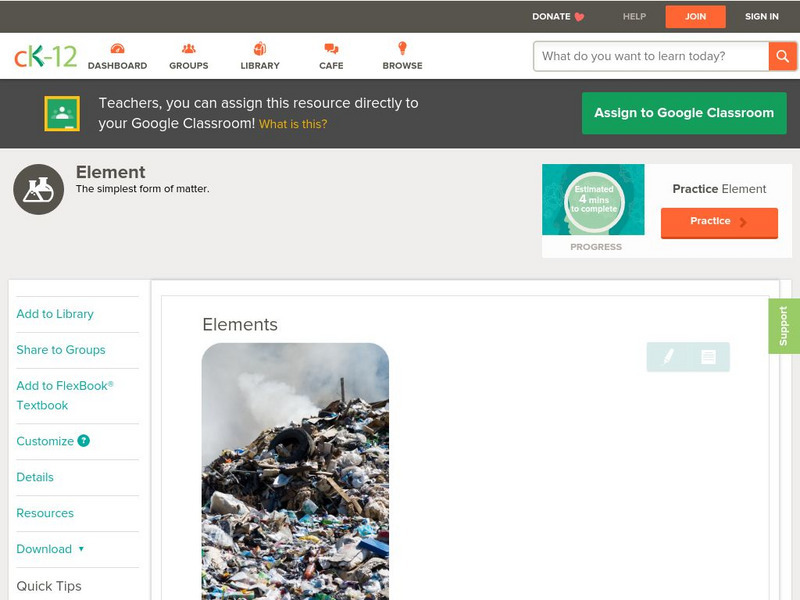Hi, what do you want to do?
Curated OER
Using Radioactive Decay To Determine Age
Students explore the process of carbon dating fossils to determine their age. They simulate radioactive decay using pennies in a shoe box. Heads represents a decayed atom each time they shake the box. They use the data to calculate the...
Curated OER
Naming Inorganic Compounds
In this compounds worksheet, students review how to name inorganic compounds and then complete 2 graphic organizers naming the cations and anions.
Curated OER
Radioactive Decay/Half Life
Students demonstrate radioactive decay using candy corns. In this Physics lesson, students make predictions, collect data and form conclusions about patterns in radioactive decay.
Curated OER
What Is Electricity?
Students investigate vocabulary words associated with electricity. In this electrical lesson plan, students utilize the Internet to research what electricity is and how it works. Students create an actual circuit in class...
Curated OER
If My Configurations are Correct
Students write the electron configuration of elements in the ground state. In this chemistry lesson, students draw how subatomic particles are arranged in the atom. They construct Lewis dot diagrams of valence electrons.
Curated OER
Hydrogen Powered Cars
Students apply the principles of chemistry to investigate the concept of how a hydrogen powered car works. They study the electrochemical reactions that provide the energy source. Students also record observations in the functioning of a...
Curated OER
Naming III-Identifying Problems Chemical Compound Names
In this naming chemical compounds worksheet, students are given 9 lettered statements that they use to match with 10 statements about compounds. Students also review the rules for naming compounds by filling in 25 blanks to complete...
Curated OER
Covalent Bonds
After a short introduction, chemistry aces get right into drawing electron dot diagrams for covalent bonds. There are only three questions to answer, so this is not a comprehensive worksheet. It can be used when introducing your class to...
Curated OER
The Life Cycle of a Star
For this stars worksheet, students read about the different stages in the life cycle of a star. Then students complete 3 short answer questions.
Curated OER
Bouncing Balls
Students create a polymer ball in the lab. In this chemistry lesson, students identify the different properties of the polymer they created. They explain what type of chemical reaction took place.
Curated OER
Using the Stock System
For this compounds worksheet, learners learn the rules for naming compounds, the stock system. Students apply these rules by writing the names or formulas for the 20 given compounds.
Curated OER
Covalent Bonding-Electron Dot Structures
In this chemistry, students draw the Lewis structures of 20 covalent compounds. They demonstrate how the lone pairs are distributed in the molecule.
Curated OER
What is a Nanometer?
Students develop a concept of the relative size of objects in the nanoscale. They complete an internet assignment using the website,"Scaling the Universe to Your Desktop". Using analogies to common objects they get an appreciation for...
Curated OER
Honors Chemistry I
In this honor chemistry I worksheet, students use all available resources to answer each question given. Students apply their knowledge of light, quantum theory of light, Bohr's model, photoelectric theory.
Curated OER
Pauli's Magical Water
Students predict the shape of molecules using VSEPR theory. In this chemistry instructional activity, students differentiate a polar and nonpolar molecule. They discuss why water's polarity is very important.
Curated OER
Code Makers - Electron Configuration, Aufbau Principle
Students write the electron configuration of elements using the Aufbau principle. In this chemistry instructional activity, students build their own key that demonstrates the principle.
Curated OER
Grating Spectrometer
Learners calculate the Balmer series. In this physics lesson, students observe hydrogen lamp spectra using spectrometers. They calculate wavelength and compare them with their theoretical calculations.
Curated OER
The Great Gas Race
Fourth graders improve their understanding of Graham's Law by using properties of gases to evaluate the rate of effusion of two compounds as they vaporize. They engage in a lab which elevates their understanding of the properties of gases.
Curated OER
Exploring the Solar System
Your students can learn more about our solar system with these lesson plan ideas.
Curated OER
Classifying Matter Game
Students identify the different states of matter. In this chemistry lesson, students differentiate the physical properties of the three states. They apply what they learned by playing a team game at the end of the lesson.
Curated OER
Energy Dispersive Spectroscopy
Students calculate the values of electron binding energies. In this physics lesson, students solve for different wavelength characteristics of X-rays. They present their findings to the class.
Khan Academy
Khan Academy: Biology: Chemistry of Life: Matter, Elements, and Atoms
Did you know matter is made up of atoms? In this article learn about the smallest unit of matter called the atom.
CK-12 Foundation
Ck 12: Physical Science: Elements
[Free Registration/Login may be required to access all resource tools.] Discusses elements and their different properties, the history of elements, and how atoms relate to elements.
Thomas Jefferson National Accelerator Facility
Jefferson Lab: Atoms, Elements and Molecules: Questions and Answers
Read common questions and answers about atoms, elements and molecules.




























